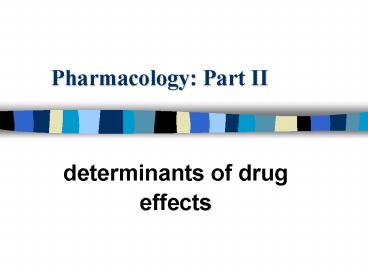Pharmacology: Part II - PowerPoint PPT Presentation
1 / 14
Title:
Pharmacology: Part II
Description:
HSS 4933 - Drug Education. Distribution: Influence of other drugs and foods ... HSS 4933 - Drug Education. Drug-Drug Interactions. Independent - no apparent ... – PowerPoint PPT presentation
Number of Views:32
Avg rating:3.0/5.0
Title: Pharmacology: Part II
1
Pharmacology Part II
- determinants of drug effects
2
Absorption
- Concentration of the drug
- dose response curve (ED, TD, LD)
- therapeutic index (TD1ED99)
- Solubility in water
- Surface area where absorption takes place
3
Absorption
- Route of administration
- Blood flow
- pH gradient between drug and the absorption
surface
4
Route of Administration
5
Distribution
- Patterns
- largely within blood stream (coumadin)
- uniformly throughout the body (alcohol)
- unevenly, dependent on membrane permeability
(penicillin) - concentrated in one or more body tissues / organs
(nitroglycerine) - Bioavailability
- bioequivalence (Note. generics)
6
Distribution
- Combination with blood plasma proteins
- low affinity (sulfa drugs, antibiotics, alcohol,
aspirin) - high affinity (marijuana, phenobarbital,
psychedelics, narcotics) - Lipid solubility (marijuana, vitamins A, D, E
K) - Bioequivalence (Note. generics)
7
Distribution
- Influence of other drugs and foods
- tetracycline and antacids / milk
- antihypertensives and licorice
- antidepressants (MAO inhibitors) and aged foods
(wine, cheese, etc.) - Cerebral blood flow, influenced by brain
stimulation - Blood-brain barrier
8
Drug-Drug Interactions
- Independent - no apparent influence on effects
- Antagonistic - one drug inhibits the effects of
the other - Additive - combining of effects, usually by
chemically similar drugs
- Potentiation - exagerration of effects of one
drug due to the presence of another - Synergism - exagerration of effects for both
drugs
9
Detoxification Removal
- Enzyme systems
- liver
- blood plasma
- kidneys
- General process
Active Drug Substances (non-polar)
Inactive Substances (polar)
Exceptions codeine psychedelics
10
Other Key Principles
- Tolerance
- Withdrawal
- Rebound effects
11
Other Key Principles
- Rebound effects
12
Determinants of Drug Responsiveness Human
- Age
- immature enzyme systems
- impaired enzyme systems
- Height and Weight (as they relate to blood
volume) - Gender
- metabolic rate differences
- hormonal variations
13
Determinants of Drug Responsiveness Human
- Biological rhythms
- insulin and blood sugar
- allergy medications and sleep cycle
- caffeine and energy levels
- Genetic predisposition
- Physiological state
- Placebo effect
14
Determinants of Drug Responsiveness Environment
- Physical environment
- ambient temperature
- crowding conditions
- novelty of experience
- level of illumination, sound, etc.
- Task variables (e.g., need for concentration)

